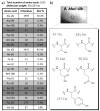Biomedical applications of chemically-modified silk fibroin
- PMID: 20161439
- PMCID: PMC2790051
- DOI: 10.1039/b905802h
Biomedical applications of chemically-modified silk fibroin
Abstract
Silk proteins belong to a class of unique, high molecular weight, block copolymer-like proteins that have found widespread use in biomaterials and regenerative medicine. The useful features of these proteins, including self-assembly, robust mechanical properties, biocompatibility and biodegradability can be enhanced through a variety of chemical modifications. These modifications provide chemical handles for the attachment of growth factors, cell binding domains and other polymers to silk, expanding the range of cell and tissue engineering applications attainable. This review focuses on the chemical reactions that have been used to modify the amino acids in silk proteins, and describes their utility in biomedical applications.
Figures









Similar articles
-
Nonmulberry silk proteins: multipurpose ingredient in bio-functional assembly.Biomed Mater. 2021 Sep 22;16(6). doi: 10.1088/1748-605X/ac20a0. Biomed Mater. 2021. PMID: 34428758 Review.
-
Silk protein-based hydrogels: Promising advanced materials for biomedical applications.Acta Biomater. 2016 Feb;31:17-32. doi: 10.1016/j.actbio.2015.11.034. Epub 2015 Nov 18. Acta Biomater. 2016. PMID: 26602821 Review.
-
Silk fibroin hydrogels for biomedical applications.Smart Med. 2022 Dec 23;1(1):e20220011. doi: 10.1002/SMMD.20220011. eCollection 2022 Dec. Smart Med. 2022. PMID: 39188746 Free PMC article. Review.
-
Bioactive Silk Fibroin-Based Hybrid Biomaterials for Musculoskeletal Engineering: Recent Progress and Perspectives.ACS Appl Bio Mater. 2021 Sep 20;4(9):6630-6646. doi: 10.1021/acsabm.1c00654. Epub 2021 Aug 9. ACS Appl Bio Mater. 2021. PMID: 35006966
-
Recent Developments of Silk-Based Scaffolds for Tissue Engineering and Regenerative Medicine Applications: A Special Focus on the Advancement of 3D Printing.Biomimetics (Basel). 2023 Jan 2;8(1):16. doi: 10.3390/biomimetics8010016. Biomimetics (Basel). 2023. PMID: 36648802 Free PMC article. Review.
Cited by
-
Applications of Silk Fibroin in Human and Veterinary Medicine.Materials (Basel). 2023 Nov 11;16(22):7128. doi: 10.3390/ma16227128. Materials (Basel). 2023. PMID: 38005058 Free PMC article. Review.
-
Processing Techniques and Applications of Silk Hydrogels in Bioengineering.J Funct Biomater. 2016 Sep 14;7(3):26. doi: 10.3390/jfb7030026. J Funct Biomater. 2016. PMID: 27649251 Free PMC article. Review.
-
Silk Fibroin Improves the Biological Properties of Egg White-Based Bioink for the Bioprinting of Tissue Engineering Materials.ACS Omega. 2023 Nov 27;8(49):46685-46696. doi: 10.1021/acsomega.3c05810. eCollection 2023 Dec 12. ACS Omega. 2023. PMID: 38107927 Free PMC article.
-
Chitosan/Silk Fibroin Materials for Biomedical Applications-A Review.Polymers (Basel). 2022 Mar 26;14(7):1343. doi: 10.3390/polym14071343. Polymers (Basel). 2022. PMID: 35406217 Free PMC article. Review.
-
Towards Non-stick Silk: Tuning the Hydrophobicity of Silk Fibroin Protein.Chembiochem. 2022 Nov 18;23(22):e202200429. doi: 10.1002/cbic.202200429. Epub 2022 Sep 22. Chembiochem. 2022. PMID: 35998090 Free PMC article.
References
-
- Zhou CZ, Confalonieri F, Jacquet M, Perasso R, Li ZG, Janin J. Proteins. 2001;44:119–122. - PubMed
-
- Heslot H. Biochimie. 1998;80:19–31. - PubMed
-
- Horan RL, Antle K, Collette AL, Wang Y, Huang J, Moreau JE, Volloch V, Kaplan DL, Altman GH. Biomaterials. 2005;26:3385–3393. - PubMed
-
- Wang X, Wenk E, Matsumoto A, Meinel L, Li C, Kaplan DL. J Control Release. 2007;117:360–370. - PubMed
Grants and funding
LinkOut - more resources
Full Text Sources
Other Literature Sources
